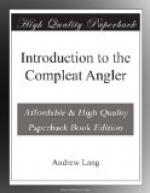On Dec. 27, 1626, Walton married, at Canterbury, Rachel Floud, a niece, on the maternal side, by several descents, of Cranmer, the famous Archbishop of Canterbury. The Cranmers were intimate with the family of the judicious Hooker, and Walton was again connected with kinsfolk of that celebrated divine. Donne died in 1631, leaving to Walton, and to other friends, a bloodstone engraved with Christ crucified on an anchor: the seal is impressed on Walton’s will. When Donne’s poems were published in 1633, Walton added commendatory verses:—
’As all lament
(Or should) this general cause of
discontent.’
The parenthetic ‘or should’ is much in Walton’s manner. ’Witness my mild pen, not used to upbraid the world,’ is also a pleasant and accurate piece of self-criticism. ‘I am his convert,’ Walton exclaims. In a citation from a manuscript which cannot be found, and perhaps never existed, Walton is spoken of as ’a very sweet poet in his youth, and more than all in matters of love.’ {1} Donne had been in the same case: he, or Time, may have converted Walton from amorous ditties. Walton, in an edition of Donne’s poems of 1635, writes of
’This book (dry emblem) which
begins
With love; but ends with tears and
sighs for sins.’
The preacher and his convert had probably a similar history of the heart: as we shall see, Walton, like the Cyclops, had known love. Early in 1639, Wotton wrote to Walton about a proposed Life of Donne, to be written by himself, and hoped ’to enjoy your own ever welcome company in the approaching time of the Fly and the Cork.’ Wotton was a fly-fisher; the cork, or float, or ‘trembling quill,’ marks Izaak for the bottom-fisher he was. Wotton died in December 1639; Walton prefixed his own Life of Donne to that divine’s sermons in 1640. He says, in the Dedication of the reprint of 1658, that ’it had the approbation of our late learned and eloquent King,’ the martyred Charles I. Living in, or at the corner of Chancery Lane, Walton is known to have held parochial office: he was even elected ‘scavenger.’ He had the misfortune to lose seven children—of




